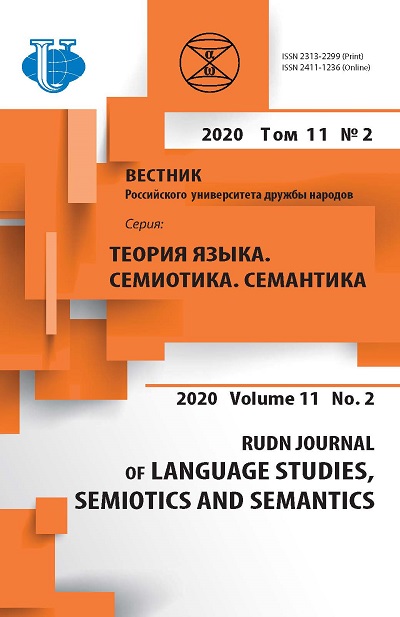Semantic Continuumof Myth
- Authors: Vladimirova T.E.1,2
-
Affiliations:
- Lomonosov Moscow State University
- Peoples’ Friendship University of Russia (RUDN University)
- Issue: Vol 11, No 2 (2020): Semantics of Universal and Specific in the Language and a Text
- Pages: 161-174
- Section: SYMBOLISM AND METALANGUAGE IN LINGUISTICS
- URL: https://journals.rudn.ru/semiotics-semantics/article/view/23575
- DOI: https://doi.org/10.22363/2313-2299-2020-11-2-161-174
- ID: 23575
Cite item
Full Text
Abstract
Language, the first cultural phenomenon, received textual expression in myths, of which the oldest tell of the mystical relationship of the tribe with the animal. Consideration of the concepts that arose on this basis, and then of “conceptual myths” (OM Freidenberg) about the totem-ancestor makes it possible to analyze their semantic-semantic fields. Moreover, we relied on the cultural-historical concept of G.G. Shpet, which allowed us to trace the evolution and subsequent transformation of the semantic-semantic fields of myth and thus reveal the algorithm for the formation of the mythopoetic tradition, its fading and eternal return. In the center of this work is semantic-semantic fields of myths about the Heavenly deer / moose cow, the cult which stretched over the more than six millennia. Observing the astral objects that served as a spatial-temporal reference point in the hunting and reindeer herding, primitive tribes felt their unity with the star ancestors. For example, two constellations of seven stars, which served the primitive hunters and reindeer breeders as a guide on the way, began to be identified in the russian North with the horned Reindeer Mother / moose cow and her daughter, from which the well-being of people depends. The attempt of comparative-historical reconstruction of semantic-semantic fields in article based on the material of myths about totems-forefathers made it possible to distinguish three main layers. These are 1) the energetically “charged” field of the myth of the shaman visiting the fantastic deer in labor, in which the religious and mythological consciousness received expression; 2) a semantic-semantic field of myths that belong to the artistic and heroic consciousness and narrate about a cultural hero who is ready for a feat for his family-tribal community; 3) the semantic-semantic field of the myth of the Horned mother-deer in the story of Ch. T. Aitmatova’s “White Steamboat (After the Tale)”, the rescue of orphans who became the ancestors of the Bugu tribe (‘deer’), and contains deep thoughts of the author, the bearer of cultural-historical and philosophicalcultural consciousness. As for the semantic-semantic fields, specific to the various interpretations of plots about a moose cow and a calf, close to a household fairy tale, a hunting story and a joke, so they correspond to the scientific and technical type of consciousness that has lost its connection with myth.
Keywords
About the authors
Tatyana E. Vladimirova
Lomonosov Moscow State University; Peoples’ Friendship University of Russia (RUDN University)
Author for correspondence.
Email: yusvlad@rambler.ru
Doctor of Philology, Professor, Department of Intercultural Communication, Institute of Russian Language and Culture, Moscow State University Lomonosov and professor of the department of the Russian language and intercultural communication of the faculty of humanities and social sciences of the RUDN University
Krzhizhanovskogo st. 24/35, Moscow, Russian Federation, 117218; Miklukho-Maklaya str., 6, Moscow, Russian Federation, 117198References
- Leont’ev, A.A. (2001). Linguistic consciousness the image of the world In Language and speech activity in general and pedagogical psychology. Moscow: Izd-vo Mosk. psihologosocial’nogo in-ta; Voronezh: Izd-vo NPO «MODEHK». pp. 139—280. (In Russ.).
- Zinchenko, V.P. (2010). Consciousness as a creative act. Moscow: YAzyki slavyanskih kul’tur. (In Russ.).
- Mamardashvili, M.K. (1992). As I understand the philosophy. Moscow: Progress. (In Russ.).
- Maslov, Yu.S. (1987). Introduction to Linguistics: Textbook. for filol. specialist. universities. Moscow: Vyssh. Shk. (In Russ.).
- Vladimirova, Т.Е. (2012). A metalinguistic paradigm for the study of a linguistic personality. Metaphysics, 4 (6), 26—38. (In Russ.).
- Fasmer, М. (1996). Etymological dictionary of the Russian language: in 4 vol. Vol. 3. St. Petersburg: Terra–ABC. (In Russ.).
- Gamkrelidze, T.V. & Ivanov, V.V. (1984). Indo-European language and Indo-Europeans. Reconstruction and historical-typological analysis of proto-language and protoculture. Tbilisi: Izd. Tbiliskogo univ. (In Russ.).
- Rezhabek, E.Ya. (2003). Mythology (cognitive analysis). Moscow: Editorial URSS. (In Russ.).
- Dal’, V.I. (1979). Dictionary of the living great Russian language: in 4 vols. 7th ed. Moscow: Russkiy yazyk. Vol. 2. (In Russ.).
- Dyachenko, G. (1993). Complete Church Slavonic Dictionary. Moscow: Izdat. otdel Moskov. Patriarkhata. (In Russ.).
- Rybakov, B.A. (1994). Paganism of the ancient Slavs. Moscow: Nauka. (In Russ.).
- Complete collection of Russian chronicles (1998). Vol. 1: Ipatiev Chronicle. Moscow: Yazyki russkoy kul’tury. (In Russ.).
- Sreznevsky, I.I. (1958). Materials for the dictionary of the Old Russian language on written monuments: in 3 vols. Stereotype edition. Moscow: GIINS. Vol. 3. (In Russ.).
- Shapovalova, G. N. (1973). The North Russian Deer Legend In Folklore and ethnography of the Russian North. Leningrad: Nauka. pp. 209—223. (In Russ.).
- Anisimov, A.F. (1959). Cosmological representations of the peoples of the North. Moscow; Leningrad: Izd. AN SSSR. (In Russ.).
- Dickson, O. (2000). Raven clan shamanistic teachings. Moscow: Refl-book. (In Russ.).
- Mazin, A.I. (1984). Traditional beliefs and ceremonies of Evenki-Orochons (late 19th — early 20th century). Novosibirsk: Nauka. (In Russ.)
- Vladimirova, Т.Е. (2017). The sacred code of Eurasian myths about a totem-ancestor. Siberian Journal of Philology, 3, 5—18. doi: 10.17223/18137083/60/1. (In Russ.).
- Myths and legends of the peoples of the world (2004). The nationalities of Russia. Moscow: Mir knigi. (In Russ.).
- Siberian tales (1964). Novosibirsk: Zap.-Sib. Print publishing house. (In Russ.).
- Altai myths and legends. Oral creativity of the Altai people (1994). Gorno-Altaysk: Izd. Ak Chechek. (In Russ.).
- Aitmatov, Ch.T. (1980). Everything concerns all. Questions of literature, 12, 3—14. (In Russ.).
- Valikhanov, Ch.Ch. (1961). Collected Works: 5 vols. Vol. 1. Notes on Kyrgyz. Alma-Ata: Civil Heritage. (In Russ.).
- Aitmatov, Ch.T. (1993). White ship (After the fairy tale). Moscow: Sunday. (In Russ.).
Supplementary files












